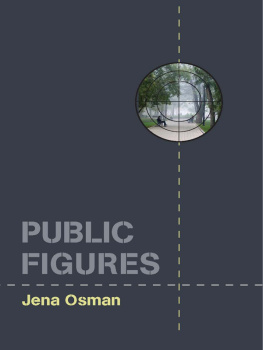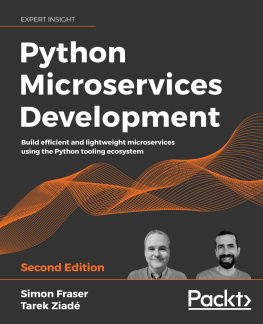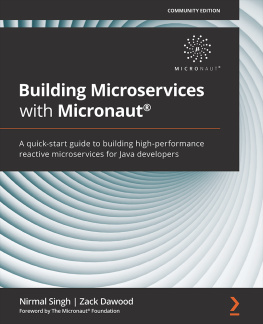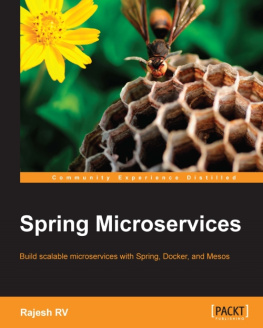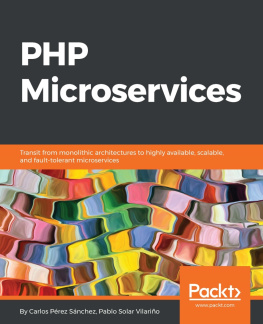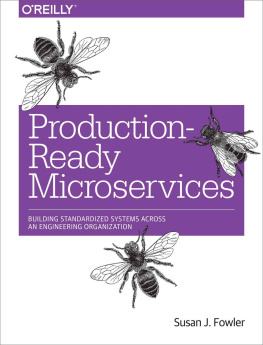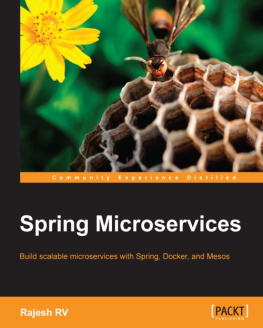Osman - Microservices Development Cookbook
Here you can read online Osman - Microservices Development Cookbook full text of the book (entire story) in english for free. Download pdf and epub, get meaning, cover and reviews about this ebook. year: 2018, publisher: Packt Publishing, Limited, genre: Computer. Description of the work, (preface) as well as reviews are available. Best literature library LitArk.com created for fans of good reading and offers a wide selection of genres:
Romance novel
Science fiction
Adventure
Detective
Science
History
Home and family
Prose
Art
Politics
Computer
Non-fiction
Religion
Business
Children
Humor
Choose a favorite category and find really read worthwhile books. Enjoy immersion in the world of imagination, feel the emotions of the characters or learn something new for yourself, make an fascinating discovery.

Microservices Development Cookbook: summary, description and annotation
We offer to read an annotation, description, summary or preface (depends on what the author of the book "Microservices Development Cookbook" wrote himself). If you haven't found the necessary information about the book — write in the comments, we will try to find it.
Osman: author's other books
Who wrote Microservices Development Cookbook? Find out the surname, the name of the author of the book and a list of all author's works by series.
Microservices Development Cookbook — read online for free the complete book (whole text) full work
Below is the text of the book, divided by pages. System saving the place of the last page read, allows you to conveniently read the book "Microservices Development Cookbook" online for free, without having to search again every time where you left off. Put a bookmark, and you can go to the page where you finished reading at any time.
Font size:
Interval:
Bookmark:
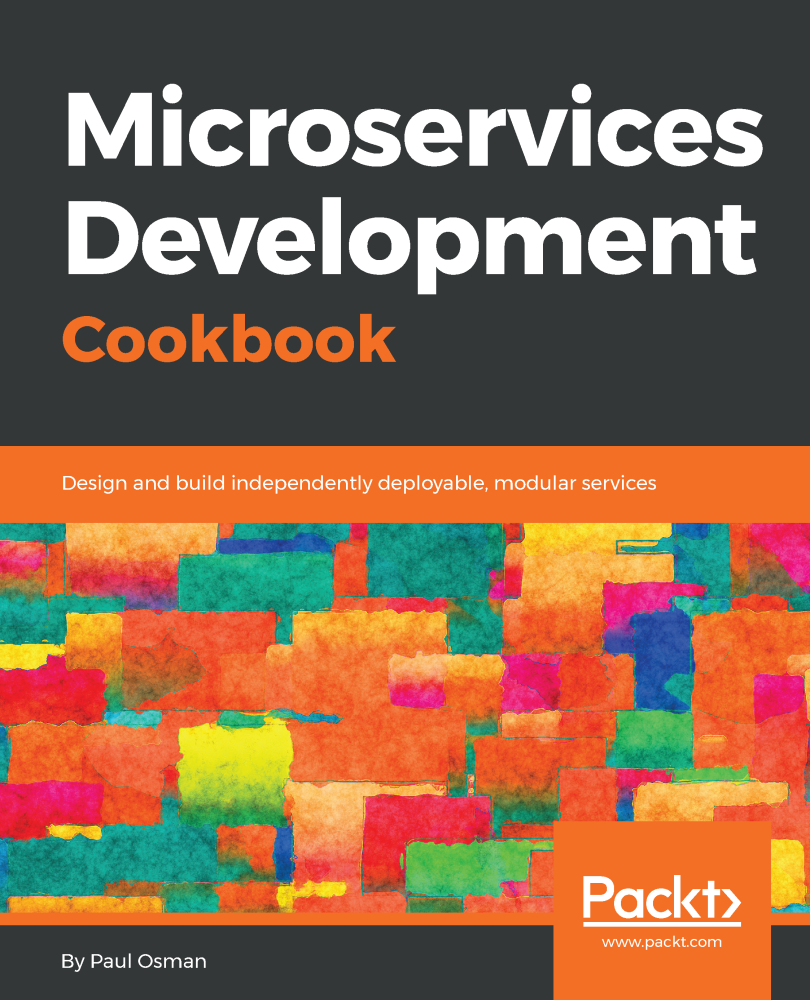

Copyright 2018 Packt Publishing
All rights reserved. No part of this book may be reproduced, stored in a retrieval system, or transmitted in any form or by any means, without the prior written permission of the publisher, except in the case of brief quotations embedded in critical articles or reviews.
Every effort has been made in the preparation of this book to ensure the accuracy of the information presented. However, the information contained in this book is sold without warranty, either express or implied. Neither the author, nor Packt Publishing or its dealers and distributors, will be held liable for any damages caused or alleged to have been caused directly or indirectly by this book.
Packt Publishing has endeavored to provide trademark information about all of the companies and products mentioned in this book by the appropriate use of capitals. However, Packt Publishing cannot guarantee the accuracy of this information.
Technical Reviewer : Matt McLarty
Commissioning Editor: Merint Mathew
Acquisition Editor: Alok Dhuri
Content Development Editor: Rohit Kumar Singh
Technical Editor: Ruvika Rao
Copy Editor: Safis Editing
Project Coordinator: Vaidehi Sawant
Proofreader: Safis Editing
Indexer: Mariammal Chettiyar
Graphics: Jason Monteiro
Production Coordinator: Shantanu Zagade
First published: August 2018
Production reference: 1300818
Published by Packt Publishing Ltd.
Livery Place
35 Livery Street
Birmingham
B3 2PB, UK.
ISBN 978-1-78847-950-9
www.packtpub.com

Mapt is an online digital library that gives you full access to over 5,000 books and videos, as well as industry leading tools to help you plan your personal development and advance your career. For more information, please visit our website.
Spend less time learning and more time coding with practical eBooks and Videos from over 4,000 industry professionals
Improve your learning with Skill Plans built especially for you
Get a free eBook or video every month
Mapt is fully searchable
Copy and paste, print, and bookmark content
Did you know that Packt offers eBook versions of every book published, with PDF and ePub files available? You can upgrade to the eBook version at www.PacktPub.com and as a print book customer, you are entitled to a discount on the eBook copy. Get in touch with us at service@packtpub.com for more details.
At www.PacktPub.com , you can also read a collection of free technical articles, sign up for a range of free newsletters, and receive exclusive discounts and offers on Packt books and eBooks.
Paul Osman has been building external and internal platforms for over 10 years. From public APIs targeted at third parties to internal platform teams, he has helped build distributed systems that power large-scale consumer applications. He has managed teams of engineers to rapidly deliver service-based software systems with confidence.
Paul has published articles and given multiple conference talks on microservices and DevOps. He is a passionate advocate of open technology platforms and tools.
If you're interested in becoming an author for Packt, please visit authors.packtpub.com and apply today. We have worked with thousands of developers and tech professionals, just like you, to help them share their insight with the global tech community. You can make a general application, apply for a specific hot topic that we are recruiting an author for, or submit your own idea.
Microservices has become an increasingly popular subject over the last few years. As with any new architectural concept, there is plenty of room for misunderstanding. Even the term microservices is confusing. Newcomers are often unsure about the appropriate size of a microservice ( hint: it's not actually about the size of the code base) and can get stuck on how to get started with this architectural style.
Service-oriented architectures are nothing new. Web services were being promoted by various companies in the 1990s as a solution to large, inflexible code bases. The promise was that web services would provide reusable capabilities that could be easily consumed by your code bases. Technologies such as SOAP and WSDL started gaining adoption, but never seemed to deliver on the ease of use promise. Meanwhile, open source languages such as PHP, Ruby, and Python with frameworks such as Symfony, Rails, and Django made developing monolithic web-centric code bases easier.
Fast forward a couple of decades and we started seeing a renewed interest in services. So, what's changed? For one, with the advent of rich web and mobile applications, every system is now a distributed system. Thanks to the advent of cloud computing, compute and storage resources are cheaper than they've ever been. Containers are changing the way we think about deploying and operating our services. Many consumer services are outgrowing their monolithic code bases, and teams are finding them hard to scale. Microservices can help with many of these challenges.
Microservices aren't a panacea. While they have many benefits ( which we'll discuss later), they also introduce some specific challenges. Before deciding to make the move to microservices, it's important to have certain infrastructure and tooling in place. Martin Fowler has written about Microservices Prerequisites (https://martinfowler.com/bliki/MicroservicePrerequisites.html) , as has Phil Calcado (http://philcalcado.com/2017/06/11/calcados_microservices_prerequisites.html ) . I won't repeat what others have written; instead, I will just say that it pays to have a certain amount of automation and monitoring in place before you start developing microservices. Your teams should be comfortable sharing on-call duties and you should have a system for managing alerts and escalations, such as PagerDuty (http://pagerduty.com/) .
The various benefits of microservices are as discussed in the next sections.
In a monolithic code base, scaling is an all-or-nothing approach. Microservices make it easier to scale separate parts of your application based on their own needs. For example, you might have a particular part of your application that is in the critical path of every user request ( that is, authentication/authorization services), whereas other parts are only used by a subset of your users ( that is, search or messaging). Different traffic patterns will translate to different scaling needs and different techniques that should be used to scale a service. A service that requires a read for every request from a user should use a data store that makes reads cheap. Services that do not need to provide strongly consistent results can take advantage of extensive caching.
Next pageFont size:
Interval:
Bookmark:
Similar books «Microservices Development Cookbook»
Look at similar books to Microservices Development Cookbook. We have selected literature similar in name and meaning in the hope of providing readers with more options to find new, interesting, not yet read works.
Discussion, reviews of the book Microservices Development Cookbook and just readers' own opinions. Leave your comments, write what you think about the work, its meaning or the main characters. Specify what exactly you liked and what you didn't like, and why you think so.


